I’ll be blunt: Android Jones is one of the most important artists alive, right now. Despite whatever contrived statement I could make about how he is “killing the art game,” and about how “his shit is so next level,” which it literally is, any reasonable conversation of his achievements must necessarily include phrases such as: “Empire State Building,” “Sydney Opera House,” and “virtual reality pioneer.” One of the most recognized artists in Visionary Art, he is truly an individual with a vision and the capacity to make it happen. His genius and self-awareness is reflected throughout every particle of his work, which explore themes that vary from the political, to the abstract, to the transcendental. His current magnum opus Samskara is a 360, dome-projected journey into the heart of creation, that made its debut at the Boulder Planetarium, and has since been at festivals all over the country like Burning Man and Symbiosis. Friend and stranger alike can see that he is a man driven by values, ideas, and possibilities; so, fascinated by the machinery of his mind, I ventured to find what makes the droid philosophically tick, so to speak, and his vision for the future.
So, to start, your artist alias is Android Jones, what inspired that name?
The origin stories of the Android actually came from a couple of different places. My uncle actually started calling me Android when I was eight years old. I honestly don’t know why he decided on that name, I guess because Android sounds like Andy. So it was already in the mix of nicknames I was going by. A more philosophical origin would be that about twenty-eight years ago I underwent a near death experience with a major brain surgery in my front right cortex. It was an experience in which the only reason I survived was because I was kept alive through things like CRTs and CAT scans. In an organic world I would not be having this conversation. I realized that it was only through the grace of modern machines that my life was extended, so I always had an affinity for technology after that. I’ve always been really interested in tools, especially creative types of tools, and using them to kind of transition all of these organic art skills I have. I went to a school for computer animation in 96 and after I got a hold of my first wacom I knew that was where I wanted to focus my energy. I graduated from Wringling school of Art and Design in 2000. I can remember installing internet explorer when I was a sophomore in college. Creating a name for yourself on the internet was a pretty new thing back then. I would go to a search engine and type Andrew Jones and it would bring up a baseball player for the Oakland Athletics, so I realized I would probably need to create an artistic identity for myself. When using a forum you go by a username or nickname, so I figured since I’ve always gone by Android, it was unique enough and something I’ve always responded to, to just stick with it
You use the words digital alchemy and electromineralism to describe your work. What is behind those ideas?
Electromineralism is a term I came up with several years ago. I can’t really say it’s caught on very much. It basically operates under the philosophy that most art forms are a combination of the content and the medium upon which its created. The term digital artist felt very nondescriptive. It is too much an umbrella term that doesn’t speak directly to the medium. The computer isn’t necessarily the objective medium. A computer is just a name for a different combination of things. When you step back and look at a computer or laptop and ask what you’re manipulating here, you find that they’re composed of quartz, magnesium, and silicone. They are made from mining the Earth, and what’s driving the art that’s being created, what’s bringing it to life, is electricity. So I felt a more accurate way of describing my art was through a combination of those ideas.
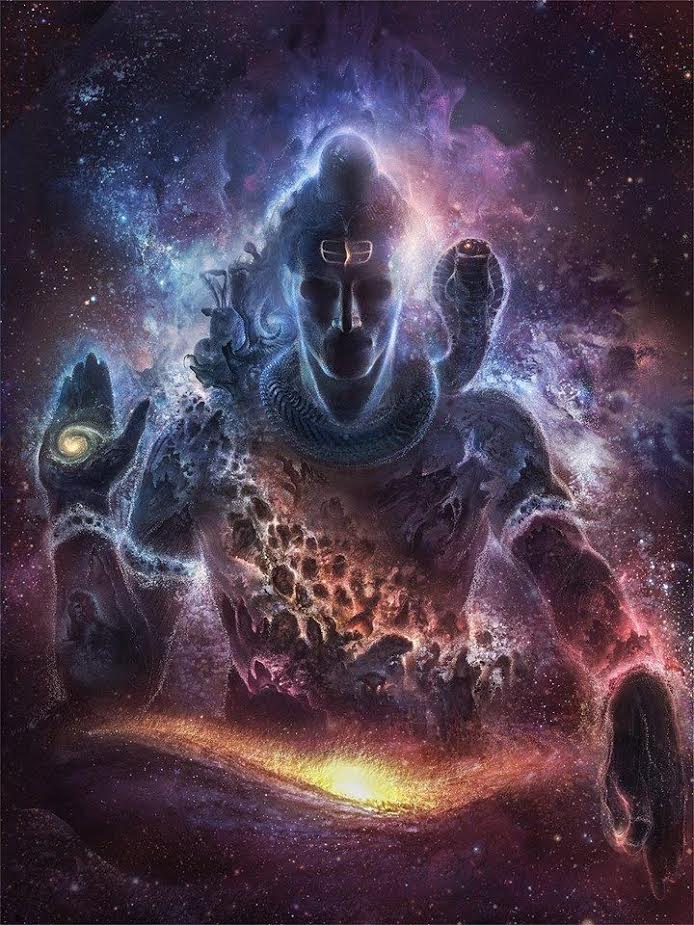
So would digital alchemy be contained in that same sort of process?
A little bit. As the alchemical process was to turn lead into gold, I feel that is sort of representative of the act of creation in general. I’m fusing all these different elements, like I said, these Earth elements, and using the electrical element of fire, and kind of forging these different elements it in the crucible of my own imagination to make something that can create this experience of the sublime, or transcendent, or transformative, and that entire process is one that I hold to be very sacred and very magical, so digital alchemy kind of came out of that philosophy.
Through what you described in the experience of your surgery and through other prior experiences, I have gathered a thread of transhumanism present in your work. Does transhumanism influence you at all?
That’s kind of tricky. In my esoteric world of conspiracy theories and ideas like that, it carries a lot of weight, but just to kind of bend it back a little bit, we are consciousness inhabiting an organic body, but this body is just made of the Earth. All the things in us, everything we eat, all of it comes from the Earth, we come out of the Earth and we go back to it, and all the technology we make is sort of a fractal of that. So on a philosophical level, the idea of using our knowledge to fuse ourselves with technology or to create some kind of vessel out of the Earth that consciousness could inhabit, there’s one element of that I think is very exciting, that could potentially be our truer purpose. On one hand you’ve got the Skynet, Terminator apocalypse, and on the other hand the prospect of giving the Earth the means to live eternally is kind of exciting. As far transhumanism, I definitely think that technology has some powerful implications for enhancing our life. Personally, I would be a little skeptical of crossing the blood-skin barrier. I don’t know how excited I would be with implanting something inside myself, but visors, or goggles, or exoskeletons, I’m all about that kind of stuff.
I do feel the technology of a human being as it is is something that deserves our unmitigated respect. The human being is a miracle of technology and machinery and right now I feel we don’t know enough about the human body and energy systems to start fiddling with it. If you can’t build something better than what you have, then I’d be careful about hacking into it because you might not be able to get it back.
As far as the transhumanism of uploading our consciousness and singularity type things, I have a lot of respect for the researchers like Ray Kurzweil and I’ve actually done some speaking at the Singularity Institute, but I’m a little skeptical about the idea of that coming online in our lifetime. I think we barely understand what consciousness is, and how can you download or transfer something if you’re not even sure what the governing dynamics of it are? Some of the transhuman singularity stories I feel are akin to some of the stories you hear in the Abrahamic religions. You know, like someday there is going to be this singularity, or some day there’s going to be this apocalypse, or some day we’re going to upload our consciousness, or some day there is going to be a rapture. It’s got more of a religious mythology feel to me than something that’s actually based in science. There’s a lot of miracles that people are asking for in between now and then that make it seem like more of a fantasy, or part of our consciousness that is attracted toward magical thinking, than something that was arrived at by taking an objective look.
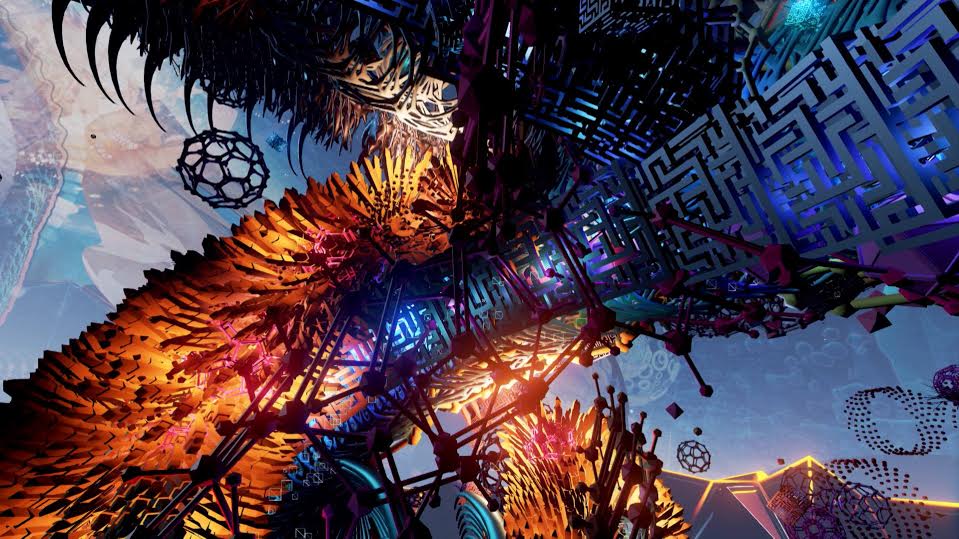 Screen capture from Jones’ Microdose VR Experience
Screen capture from Jones’ Microdose VR Experience
You were at Symbiosis this year with the Hare Krishna’s. I was wondering what your involvement with them is.
I started working on my Samskara project in April of 2015, and I was invited by this group of Hare Krishnas to fly to Thailand to potentially collaborate on a dome project. They are an amazing group of artists, and animators, and computer scientists, and a lot of them originated out of Russia and Kiev. They’ve come together under the leadership of a guy who goes by the name ‘Swami’ who is a part Russian, fully recognized, Hare Krishna Swami, who took over the lineage of his guru after he passed away. His background is in the Russian military and he emigrated to New York after serving in Afghanistan. He became an art dealer and started hustling propaganda posters and built an art empire pushing a lot of Russian artists with classical backgrounds. He ends up going to India, finds a guru, and becomes a Hare Krishna. He always had this entrepreneurial side to himself and has always been interested in technology, so he built this little mini-empire of a production company that makes domes and content for films, and his whole philosophy is basically to use technology and immersive media as a vehicle for the distribution of the philosophy of the Vedas, Upanishads, and Hindu scriptures.
I don’t know if you’ve ever taken time to read the Vedas or Yogasutras, but there is a lot of very rich and valuable information in them about the governing dynamics of human consciousness, that was given to man from ancient Indian mystics, who were meditating in caves for decades upon decades. This is information that seems to have not really come from the mind of man, but through the mind of man through their ability to enter these deep states of meditation. When you really sit down and read the Yogasutras you see that their knowledge was so vast. We like to think that we’re really contemporary and that some 7,000 year old guy meditating in a cave in the Himalayas has no relevance to modern life, but personally when I read the Sutras I feel like there is a very wise, modern, contemporary person in the room speaking directly to me, and speaking directly to all the things and problems that are happening in my life. There is a level of wisdom present that is just as true today, as it was 7,000 years ago, as it will most likely be 10,000 years into the future. There are things that are true today that will never not be true, and that kind of a truth, I feel from my perspective as an artist, and someone who brings stories to life that there is almost an obligation to reinterpret and retell those truths.
So Swami kind of saw it as his opportunity and responsibility to take the contemporary technology available and use it to to relay these ideas. So, by taking the Vedas and using 360 film projection and VR it can almost become like a spiritual technology. And you know, it’s not really just about video cards and processing power so much as the intention. All the artists and animators who work on Samskara are in Thailand right now meditating and doing Kirtan, and then will sit down and code, and 3D animate, and composite together. They are trying to create a certain quality of consciousness that they bring to the project. That’s a great example of digital alchemy, that the quality of consciousness they bring to the project reflects the power and resonance it ultimately has.
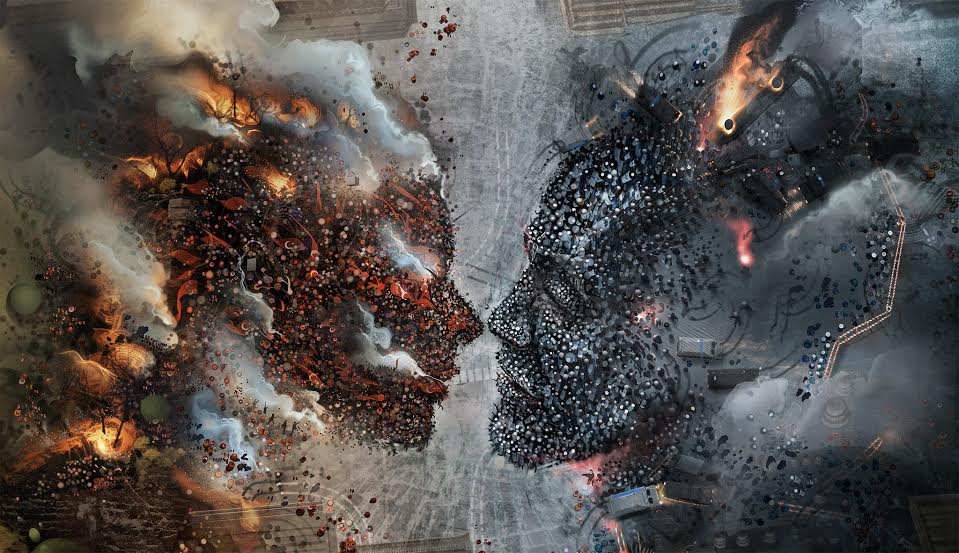
You mentioned VR a little bit ago. I was wondering if you had anymore projects like Samskara in development and how you see VR being developed as an artistic medium.
Beyond Samskara, right now we’re trying to take Samskara and make a virtual reality version of it, so it can be experienced on your phone or your oculus, which is a really powerful way to be able to experience that media. About eight months ago I had a pretty clear download from my guide who told me I need to be making art in VR. So I got access to some early versions of Medium and different programs. The first time I sat down with them was similar to the first time I tried psychedelics, where I could see the possibility of a whole new world opening up, and It gave me a lot of ideas after my first couple encounters. I wanted to collaborate with different people working on that sort of stuff, but I felt that so many of the ideas I had I could only give proper justice if I did it myself. Some of the ideas were so out there it would have been hard to find a team that would have been ready and willing to take some of the risks I wanted to take, so I ended up putting together my own small VR team between myself and two other really close friends. We all started working on a VR project together and we’re about 7 or 8 months into it. We’ve got a working prototype that we’ve been taking to Burning Man and Symbiosis and different festivals. We will launch it sometime early to mid 2017 and it’s called Microdose VR.
The concept behind Microdose is to use the platform behind VR to enable a whole new type of creative experience that’s never been possible before. We were talking about Electromineralism, a lot of the time our creativity is defined by the medium we use, and every medium has its advantages and structure, but it also has its boxes and limitations. Sometimes those limitations are important because it defines the framework of what’s possible. Sometimes structure can give you the bedrock you need to let go creatively, but I still feel that in the scope of the unlimited potential that the human being is capable of, every tool that’s available right now has its ceiling and its boxes. Like, if I’m an artist I’m predisposed to conforming around a two dimensional illustration, or if I’m a singer I’m still limited within the box of making music. It seems like we kind of find buckets to pigeonhole this infinite creative potential we have, so what I see VR doing is really opening the aperture of what our creative bandwidth is capable of. What we’re doing with Microdose is try to create a platform which is a celebration and exploration of the three types of intelligence that make up most of creative expression, which is the kinetic intelligence of dance, the audio intelligence of music creation, and the spatial intelligence of image making. What we really tried to challenge ourselves to do was create a program that allowed someone to develop on all of those levels simultaneously and create a harmonious reaction between the three. So with Microdose, at any moment you’re able to spray this cascade of undulating rainbow geometry from your hand. So your dance movements become these sort of hyperdimensional sculptures, that have these different musical elements attached to them. We hired Bluetech recently as our music guru, and so every time you activate one of these particles it activates and animates around a different instrument from his tracks. We have it to where with each one of these particles there is a direct one to one relationship with the sound that you’re hearing and the shape and color of the particles you’re seeing, so it creates this form of synesthesia where you’re actually able to dance and create these beautiful visuals, while at the same time remixing a piece of music; but what’s cool is that you’re mixing a piece of music in 360. So if you shoot a bass womp, fractal caterpillar behind your head you can actually feel it behind you and hear it behind you, or above you, or below you. We’re going to be giving people the opportunity to react with existing musicians content and stems and engage with it to where they’re not just listening to it, but they’re remixing it in a visual, three dimensional space. I feel that as we develop this technology into a platform VR will create a whole new type of art and whole new type of artist, and I just want to be part of the movement that gives people these types of tools for the exploration of their creativity.
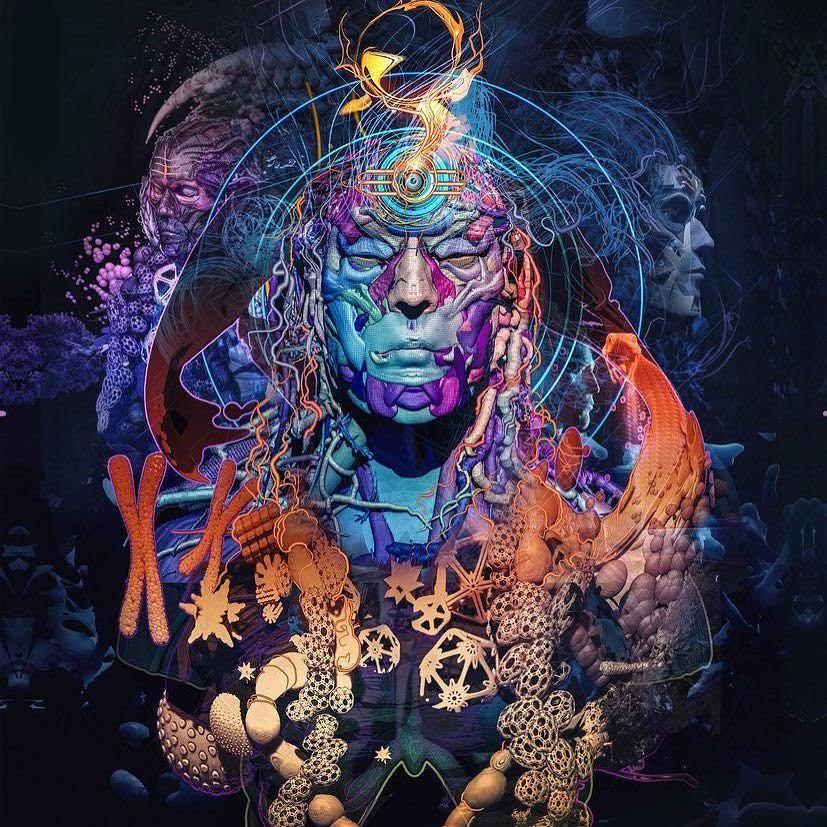
Wow, I gotta say, when I asked you that question I didn’t expect you to go into synesthesia.
We’re calling it synesthetic sculpting, where you’re actually able to sculpt a song. VR is going to give us the ability to hybridize and combine forms of art in ways that we never thought was possible before.
When I was doing my homework on you I seem to recall reading that you worked for Nintendo at some point, is that right?
I did. I started working for Nintendo shortly after I finished art school and worked there from 2000-2005. I worked developing all the concept art for the Metroid Prime Series. I would also fly out to the Seattle office to consult on some of the art for some of their other Japanese games. They basically hired me to be their American concept artist that could translate their designs into something that would be appealing to the American market.
One last question: You and Alex Grey are some of the primary names in Visionary Art. How do you see Visionary Art evolving, and what do you think makes a piece of art visionary?
That’s a good question. I have so much love and respect for Alex and everything he has created. If it wasn’t for him I probably wouldn’t have had the courage to embrace it in the way that I have. Personally, I really feel the future of Visionary Art is is electric. The way I sort of see things from an evolutionary standpoint is from the Ken Wilbur model, which is the idea that you transcend and include at the same time. So you don’t just abandon painting and drawing and go strictly VR, but rather take some of the best qualities of organic creativity and apply it to contemporary means. As far as what makes a piece visionary, I like to work under the term electromineral because there are a few things about the term visionary I’m not that excited about. It’s a little non-descript. I mean everybody has vision, but I don’t like, have a vision and then sit and try to submit it to canvas. My process is much more an intuitive explanation of my own consciousness. As far as art being a vehicle to explore our consciousness, that would resonate with me as being a part of the visionary definition. When you look across the spectrum of visionary art you can see a piece in Carey Thompson’s work get echoed in a Luke Brown piece, or Xavi, or Amanda Sage. With all the visionary artists it’s like there’s this fourth dimensional elephant out in hyperspace and we’re all feeling out a different part of it and then bringing that piece back to the world to share. You can’t really understand visionary art just looking at my work or Alex Grey’s work, you need to look at it all at once kaleidoscopically.
I don’t think Visionary Art is something that is supposed to provide answers, but I do think that it asks the right questions. I think the visionary is concerned with, ya know: why are we here? What is the nature of our reality? What’s the nature of consciousness? Of dreams? What exists beyond the material world of our senses? These sorts of questions I think create a canon sort of, of what visionary art is about, and more than anything I think it is about exploring and interacting with the divine spirit of creativity. That’s what makes it interesting and exciting to me. VR and visionary art are alike in that they both are recapitulations of reality, but they both challenge you to question the nature of your reality, and the enquiry of that I think will continue to be the future of visionary art. It’s a question that part of me hopes we’ll never have answers to, because the exploration of the question is actually more valuable than any answer that may or may not be.
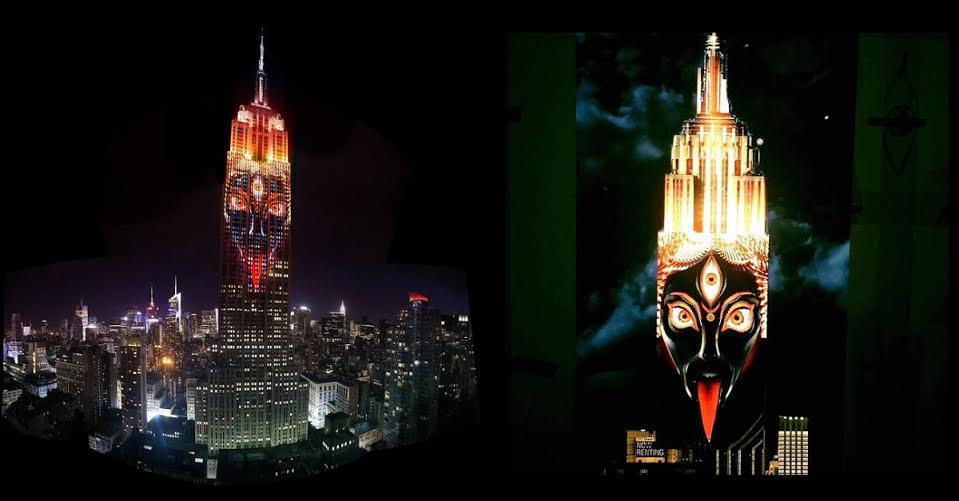
Author Bio
Buckley Rue hails from Fort Worth/Austin Texas. He graduated from the university of Texas at Austin where he has a degree in Religious Studies with a minor in Psychology. He is the school’s founder of Students For Sensible Drug Policy and has a deep passion for psychedelic therapy. He is currently wrapping up a novel titled “Afterlife”, about the rise of The American rave culture, the coming revolution in consciousness, and the dawning of a new age for mankind.
Check out Rue’s book, Afterlife, a story of individual and global transformation which explores the depths of mental illness, religion, life, death, and the American way of life; laying down a prophecy with the potential to reshape life as we know it.

